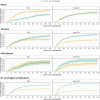Neurological manifestations of COVID-19 in adults and children
- PMID: 36087305
- PMCID: PMC9494397
- DOI: 10.1093/brain/awac332
Neurological manifestations of COVID-19 in adults and children
Abstract
Different neurological manifestations of coronavirus disease 2019 (COVID-19) in adults and children and their impact have not been well characterized. We aimed to determine the prevalence of neurological manifestations and in-hospital complications among hospitalized COVID-19 patients and ascertain differences between adults and children. We conducted a prospective multicentre observational study using the International Severe Acute Respiratory and emerging Infection Consortium (ISARIC) cohort across 1507 sites worldwide from 30 January 2020 to 25 May 2021. Analyses of neurological manifestations and neurological complications considered unadjusted prevalence estimates for predefined patient subgroups, and adjusted estimates as a function of patient age and time of hospitalization using generalized linear models. Overall, 161 239 patients (158 267 adults; 2972 children) hospitalized with COVID-19 and assessed for neurological manifestations and complications were included. In adults and children, the most frequent neurological manifestations at admission were fatigue (adults: 37.4%; children: 20.4%), altered consciousness (20.9%; 6.8%), myalgia (16.9%; 7.6%), dysgeusia (7.4%; 1.9%), anosmia (6.0%; 2.2%) and seizure (1.1%; 5.2%). In adults, the most frequent in-hospital neurological complications were stroke (1.5%), seizure (1%) and CNS infection (0.2%). Each occurred more frequently in intensive care unit (ICU) than in non-ICU patients. In children, seizure was the only neurological complication to occur more frequently in ICU versus non-ICU (7.1% versus 2.3%, P < 0.001). Stroke prevalence increased with increasing age, while CNS infection and seizure steadily decreased with age. There was a dramatic decrease in stroke over time during the pandemic. Hypertension, chronic neurological disease and the use of extracorporeal membrane oxygenation were associated with increased risk of stroke. Altered consciousness was associated with CNS infection, seizure and stroke. All in-hospital neurological complications were associated with increased odds of death. The likelihood of death rose with increasing age, especially after 25 years of age. In conclusion, adults and children have different neurological manifestations and in-hospital complications associated with COVID-19. Stroke risk increased with increasing age, while CNS infection and seizure risk decreased with age.
Keywords: COVID-19; encephalitis; meningitis; neurological complication; seizure; stroke.
© The Author(s) 2022. Published by Oxford University Press on behalf of the Guarantors of Brain.
Conflict of interest statement
The authors report no competing interests.
Figures



References
-
- Hassett CE, Gedansky A, Migdady I, Bhimraj A, Uchino K, Cho SM. Neurologic complications of COVID-19. Cleve Clin J Med. 2020;87:729–734. - PubMed
-
- Kremer S, Lersy F, Anheim M, et al. Neurologic and neuroimaging findings in patients with COVID-19: A retrospective multicenter study. Neurology. 2020;95:e1868–e1882. - PubMed

